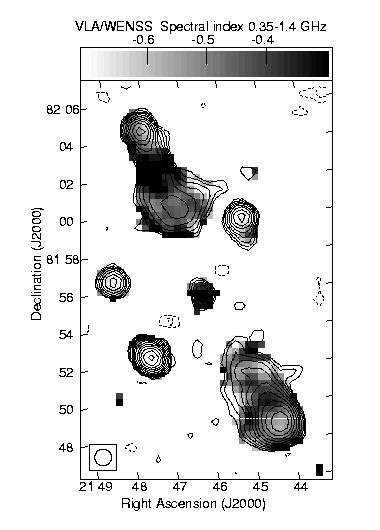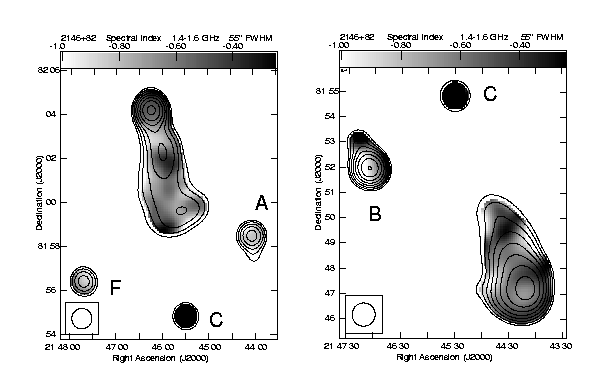Figure 8 shows the 0.35 to 1.4 GHz spectral index
distribution inferred from comparing the WENSS ([Rengelink et al. 1997]) image
with our BnC configuration image convolved to the same resolution. The northern and
southern warm spots have spectral indices5
![]() of -0.6 and -0.55, not unusual for the hot spots
of FR II sources in this frequency regime. The background sources also
exhibit spectral indices that are quite typical of extragalactic
sources (A, -0.68; B, -1.0; F, -0.7). Near the centers of the north
and south lobes of NVSS 2146+82, however, this comparison shows regions
of unusually "flat'' spectral index (
of -0.6 and -0.55, not unusual for the hot spots
of FR II sources in this frequency regime. The background sources also
exhibit spectral indices that are quite typical of extragalactic
sources (A, -0.68; B, -1.0; F, -0.7). Near the centers of the north
and south lobes of NVSS 2146+82, however, this comparison shows regions
of unusually "flat'' spectral index (![]() ~ -0.3 ± 0.02 in the north lobe,
~ -0.3 ± 0.02 in the north lobe, ![]() ~ -0.4 ± 0.03 in the south lobe).
~ -0.4 ± 0.03 in the south lobe).

Figure 8: Gray scale representation of the spectral index
distribution derived from VLA measurements at 1.4 GHz and the
0.35 GHz WENSS image with superimposed contours from the VLA image.
The resolution is 54'' (FWHM), illustrated in the
lower-left and the bar at the top gives the gray scale values.
The spectral index variations across the lobes can also be studied from
our 1.36 and 1.63 GHz data. Due to the low surface brightness the data
were tapered to 55'' resolution before imaging for this
comparison. To eliminate any complication from the mosaicing
technique, only data derived from the pointing on a given lobe were
used to determine the spectral index variations for that lobe. Thus,
the data from two pointings were imaged independently at 1.36 and 1.63
GHz, corrected for the antenna power pattern, and spectral index images
were derived independently for the two lobes. These results are shown
in Figure 9. The close spacing of the frequencies makes
determining the spectral index more difficult; but this is compensated
to some extent by the nearly identical imaging properties at the two
frequencies, which reduce systematic errors. These data sets are fully
independent of those used for the spectral index image in Figure
8, but also reveal symmetric regions of unusually flat
spectral index, ![]() ~ -0.3±0.08, in both
lobes.
~ -0.3±0.08, in both
lobes.

Figure 9: Gray scale representation of the spectral index at
55'' resolution derived from the 1.36 and 1.63 GHz data
with superimposed contours of the 1.63 GHz total intensity at the
same resolution.
The bar at the top gives the gray scale values and the resolution
is shown in the lower-left corner.
The north lobe is shown in the left and the south lobe on the right.
We conclude that four independent data sets show evidence for regions
with ![]() ~ -0.3 in regions of relatively high
signal to noise ratio. These regions are not artifacts of
"lumpiness'' in the zero levels of the images.
~ -0.3 in regions of relatively high
signal to noise ratio. These regions are not artifacts of
"lumpiness'' in the zero levels of the images.
5
![]() , as used here is given by
, as used here is given by ![]() .
.